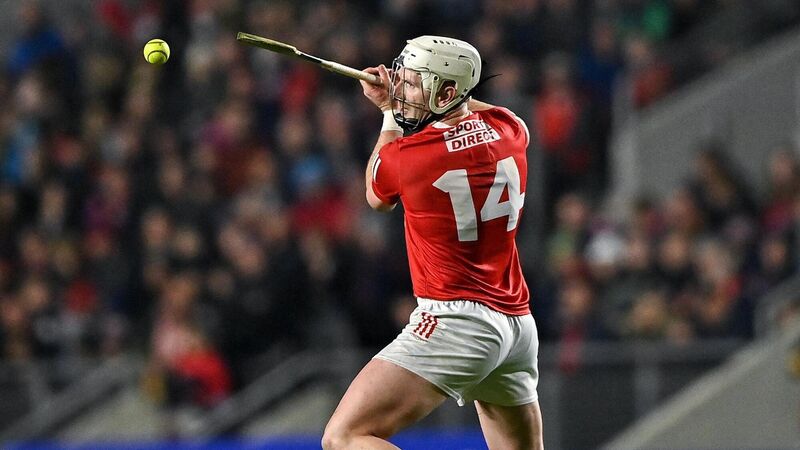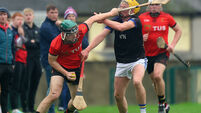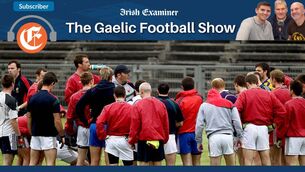Christy O'Connor: Modern teams are more hung up on precision and percentages than distance

POC FADA: Patrick Horgan of Cork takes a free. Photo by Piaras Ó Mídheach/Sportsfile
In a discussion last week, Gearóid Hegarty mentioned how he loves watching, analysing and dissecting old games. Recently, the Kilkenny-Waterford All-Ireland final popped up on his YouTube page and Hegarty decided to have a peep.
One sequence of play caught his eye. “There was a score in that game from about 100 yards just underneath the Hogan Stand, similar to the one I got this year (in the All-Ireland final),” he said. “I was just thinking ‘Isn’t that funny now that everyone talks about the ball travelling so much further nowadays than it used to’.
“I don’t know, but I don’t think so. I don’t know, are players better now or are they practising more? I don’t know if the ball is necessarily travelling further but, even if it is, I think it makes for a better game.
“People want high-scoring encounters with scores going over from everywhere. If the ball was to be made heavier or slower, it’s going to end up in games that are slower, that are not as high scoring. I don’t think the spectator wants that. I don’t think the players want that. Even if the ball is lighter now, I think it makes for a better game.”
Not everyone is in agreement.
For decades now, Michael ‘Babs’ Keating has been saying that the sliotar is too light. In another discussion last week, Keating said that the sliotar is travelling at such a pace that he, and many more like him, are losing interest in the game.
“With the ball travelling so far now, it often wouldn’t worry me if I never saw a hurling game again,” said Keating. “Hurling balls are not supposed to travel 130 yards. Would it happen in cricket or any other game? No way. The way hurling is now, my generation have no interest in it.”
There is no easy conclusion to this debate. It can’t be right that goalkeepers can score from puckouts, as Laois ‘keeper Enda Rowland did in a club game three years ago? Stephen O’Keeffe was the first goalkeeper to score from play in the championship in 2018 but new scoring thresholds have been continually crossed in the last six years: in 2016, there were 1,000 points scored in the championship for the first time, which was followed immediately by the first 1,100 point championship and the first 1,200 point championship. The numbers just keep rising.
The easy answer is that the ball is travelling too far and, while that is a key part of the issue, it’s certainly not all of it. Players are much stronger now but so is their technical proficiency, at all levels, right across the board.
The scoring zone has completely changed. By half time of this year’s All-Ireland final, the six half backs on the field had all scored from play, which was surely a first in a big hurling game.
There were times in that final when Hegarty looked like he was barely stroking the ball from long distance, and yet the sliotar was still flying over the bar like he had smashed a golf-ball with a baseball bat just 30 metres from the goal.
Hegarty is one of the strongest players to ever play the game but he’s also one of the most skilful.
When Hegarty scored his best point in the All-Ireland final, just beneath the Hogan Stand in the first half, he had the sliotar in his hand – from when he snapped the breaking ball off a puckout until he struck it – for just 0.83 of a second.
Speed now is in the player’s mind and wrists as much as in how hard they strike the ball. Gym work has made modern players far more powerful but greater distance in their striking was just a by-product of that physical empowerment.
In that climate though, making the ball heavier is not really going to alter the game from how it’s played in the current environment.
Modern teams are more hung up on precision and percentages than distance. If they weren’t, there wouldn’t be as many short puckouts.
Despite all their big men around the field, especially across their half-forward line, Limerick took 79 short puckouts in the 2022 championship. So making the ball heavier is not going to reduce short puckouts, short-passing and possession plays.
Even if the GAA wanted to make the ball heavier, it’s not that straightforward. According to the official guide, a sliotar cannot weigh less than 110 grams or more than 120g. Most balls produced now are close to the minimum weight, but there is as much as an 8 per cent difference in potential distance between the lightest ball and the heaviest ball between 110-120g.
Even within that range, there is considerable potential for variance - up to 8% of a difference between the distance a 110g and 120g ball travels. That could be the difference of a long-range free landing in the square or going over the bar.
The co-efficient of restitution — or bounciness — of the polyurethane core is also a key element in the process. So is the drag through the air generated by shallow rims. Small rims and a stable, bouncy core in the sliotar are pivotal to how the modern game has evolved.
The rim height ranged between 2mm and 2.8mm, while the width had to officially fall between 3.6mm and 5.4mm. The variance is significant, particularly in the width of the rim; even half a millimetre impacts significantly on the drag as the sliotar travels through the air.
The old ball, with thick rims and traditional cork cores, which absorbed moisture too easily, didn’t facilitate short stick passing and short puckouts. Nobody wants that old ball back but the bounciness of the current ball can be reduced by altering the polyurethane core’s composition.
The GAA have done a lot of work in recent years to try and ensure uniformity and a standardised core. When the new digital or smart sliotars were introduced earlier this year to ensure more consistency – which were used in the U20 championship – the GAA were also keen to ensure the speed of the ball isn’t impacted by the digital tag.
The sliotar workgroup chairman Ned Quinn told GAA Congress in February that the maximum mass of the ball that was permitted was lowered, as well as the parameters of the height of its rims. Yet there are no guarantees that making the sliotar heavier wouldn’t make it go as far because of the density of the core of the ball, and the coefficient of restitution.
Getting caught up with the weight of the ball though, largely misses the point in this debate about how far the sliotar is travelling. It’s not just how the game is played in terms of style, but at what temperature, which has added to hurling often feeling more sterile.
With so much short passing and protected possession, and fewer 50-50 contests, hurling doesn’t feel as exciting or as exhilarating as supporters often want it to be. And that isn’t all down to the ball travelling as far as it now is.












